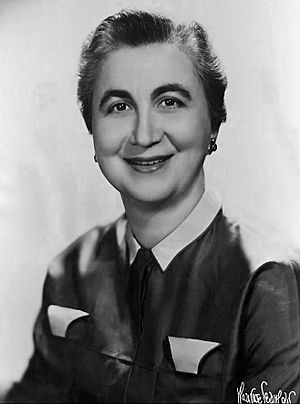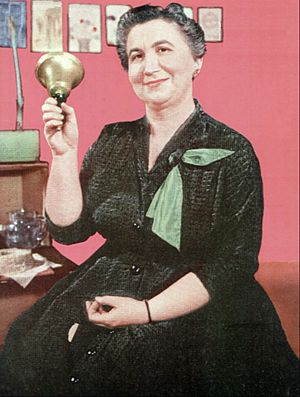Frances Horwich facts for kids
Quick facts for kids
Frances Rappaport Horwich
|
|
|---|---|

Horwich in 1955
|
|
| Born |
Frances Rappaport
July 16, 1907 Ottawa, Ohio, US
|
| Died | July 22, 2001 (aged 94) |
| Alma mater | Columbia University (M.Ed.) Northwestern University (Ed.D.) |
| Occupation | Television host Television executive Educator |
| Years active | 1952–2001 |
| Known for | Ding Dong School |
Frances Rappaport Horwich (born Frances Rappaport, July 16, 1907 – July 22, 2001) was an American educator and television star. Known as Miss Frances, she hosted the popular children's TV show Ding Dong School. This show was seen on the NBC network in the 1950s. It was later shown all over the country from 1959 to 1965. Miss Frances taught young children from their homes.
Contents
Early Life and Education
Frances Horwich was born on July 16, 1907, in Ottawa, Ohio. Her parents were Samuel and Rosa Gratz Rappaport. Her father came from Austria and owned a store. Her mother came from Russia and taught her children crafts. Her father taught them how to talk to people. He let them work at the store counter.
All of her siblings went to college. Her two brothers became doctors for children. Her two sisters also worked in healthcare. Frances was a very smart student. She skipped grades in school. She started the University of Chicago when she was only 15.
Frances earned her first degree from the University of Chicago in 1929. She then taught first grade in Evanston, Illinois. She also worked with nursery schools in Chicago. She earned her master's degree from Columbia University in 1933. Later, she directed kindergartens in Winnetka, Illinois.
She became a dean at Pestalozzi-Fröbel Teachers College in Chicago in 1938. Frances earned her doctorate degree from Northwestern University in 1942. She also worked as a counselor for students. She taught at the University of North Carolina for two years. In 1946, she became the head of the education department at Roosevelt College in Chicago.
Frances met her husband, Harvey, at a religious school. He was a lawyer and historian. They married on July 11, 1931. They did not have any children.
Ding Dong School on TV
Ding Dong School was a new idea for television. It was created by Reinald Werrenrath Jr. and Judith C. Waller. They wanted to make a TV nursery school. Miss Frances would be the teacher. Children at home would watch and join in. The show was filmed from a child's eye level. The items used on the show were kept simple. This helped young children recognize them.
Frances Horwich was asked to try out for the show. She had only been on TV for discussion shows before. She was not sure about being the only person on camera. But she agreed to try. She got the job and decided to give it a chance.
The show was first just an experiment. Many people thought it would not work. Some thought it would be a terrible mistake. So, it was aired on October 2, 1952, with no advertising. But after the show, the station got many positive calls and letters. Ding Dong School was quickly scheduled to air every weekday morning. Frances had two weeks to learn how to draw and paint upside down for the camera.
Each show started with Miss Frances ringing a school bell. She would then sing the Ding Dong School song. She would ask, "How are you this morning?" and wait for kids to answer. Miss Frances taught her TV classes just like she would in a real classroom. Other famous TV hosts, like Fred Rogers, later used this style.
Activities included drawing, finger painting, and making things with pipe cleaners. Lessons on safety, like crossing streets, were also taught. Children's drawings sent in were shown and talked about. At the end of the show, Miss Frances would ask children to get their mothers. She would then tell parents about the day's lessons. She also shared what supplies would be needed for future shows.
Ding Dong School quickly became very popular. Frances Horwich won the George Foster Peabody Award in 1952. The show began to be shown nationally on NBC in March 1953. It had 2.4 million viewers daily. Miss Frances had special rights in her contract. She could say no to sponsors. She also refused to make the show longer or move it to the afternoon. In 1953, she was named Woman of the Year in Education. She wrote many Ding Dong School books for children. She only supported products that were cheap and educational.
Becoming a TV Star
Life changed a lot for Frances and her husband after Ding Dong School. Frances woke up at 4:30 AM on weekdays. She would get ready for her show. She often prepared props in the evening.
Neither Frances nor her husband were ready for her sudden fame. Once, they were flying to the Bahamas for a vacation. Many children on the plane recognized "Miss Frances." They sang the Ding Dong School song all the way to Miami. Even in the Bahamas, a band at their hotel played the song when they entered the dining room. Her husband joked, "Just call me Mr. Frances."
Everyday life was no longer normal. Once, Frances stopped for coffee. A woman loudly said she never thought her child would see Miss Frances drinking coffee. Frances greeted the children and left. On a typical day, she might be stopped 17 times by parents and children. Children were amazed to see her in person. They would sometimes poke her to make sure she was real.
Frances made some public appearances. Crowds for her were often larger than for movie stars. She once said she shook 17,000 hands at her first appearance. At a store in Boston, 12,000 people came to see her.
Children's TV Leadership
In 1954, Frances Horwich became the Head of Children's Programming for NBC. She moved to New York in 1955. Ding Dong School then started broadcasting from New York.
In 1955, a newspaper writer warned Miss Frances about a vitamin commercial. He felt she might be encouraging children to swallow any pretty pills. In 1956, Ding Dong School was canceled. NBC wanted to air The Price Is Right instead. Frances resigned from NBC because she disagreed with the network's focus on commercials. She refused to advertise products that were not useful for children or that promoted violence. She would not accept a sponsor selling BB guns. Because of this, Ding Dong School was canceled.
Frances owned the rights to Ding Dong School. So, she signed with WGN-TV in Chicago to bring the show back in 1958. In 1959, she and her husband moved to Hollywood. The show was shown across the country until 1965. She also advised on children's activities for a publishing company. In 1965, she became the Director of Children's Programming for a new TV station in Chicago, WFLD.
Later Years and Legacy
Frances Horwich moved to Scottsdale, Arizona, in 1973. This was because of her husband's health. Harvey died in 1974. In Arizona, she gave lectures at Arizona State University. She also worked at a local public TV station. Frances Horwich died on July 22, 2001, at age 94. She passed away from heart problems.
A month before she died, Frances was honored. She was inducted into the Silver Circle of the National Academy of Television Arts and Sciences. This award honors people who have worked in TV for 25 years or more. In 2006, a special marker was placed in Ottawa, Ohio. It honors her life and contributions.
Books by Frances Horwich
Frances Horwich wrote many books for children and parents.
For Parents
- Have Fun With Your Children (1956)
- The Magic of Bringing Up Your Child (1959)
For Children
She wrote many books based on Ding Dong School themes. These included stories about daily life, animals, and learning. Some popular titles were:
- The Baby Chipmunk (1953)
- A Day Downtown With Daddy (1953)
- Your Friend, the Policeman (1953)
- Grandmother is Coming (1954)
- Miss Frances' All-Day-Long Book (1954)
- The Magic Wagon (1955)
- Miss Frances' Story Book of Pets for the Very Young (1956)
- The Ding Dong School Book (1960)


